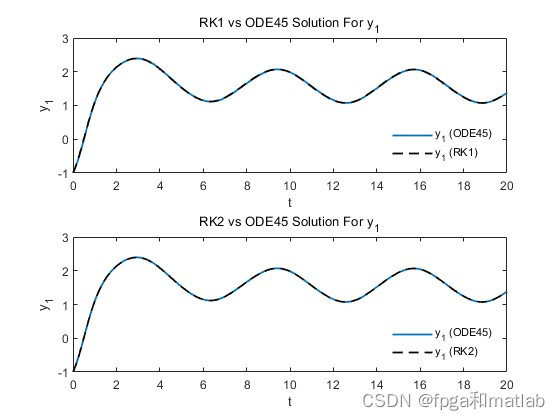目录
龙格-库塔(Runge-Kutta)方法是一种广泛应用于常微分方程初值问题的有效数值求解技术。对于偏微分方程(Partial Differential Equations, PDEs)的求解,龙格-库塔方法通常需要与离散化技术(如有限差分法、有限元法等)结合使用,将PDE转化为一系列常微分方程(Ordinary Differential Equations, ODEs),然后应用龙格-库塔算法求解这些转化后的ODE系统。
1.龙格-库塔方法概述
在讨论PDE之前,先简要回顾一下龙格-库塔方法的基本原理。考虑一阶常微分方程初值问题:
![]()
其中,y(t)是未知函数,f是给定的函数,描述了y关于时间t的变化率。龙格-库塔方法通过构建一个多项式近似来估计在时间间隔[tn,tn+1]内y的值,进而得到y(tn+1)的近似值。最简单的二阶龙格-库塔方法(RK2,也称作改进欧拉法)可表示为:

其中,ℎh是时间步长,yn和yn+1分别表示y在tn和tn+1时刻的近似值,1k1和k2是中间斜率的估计。
2.偏微分方程的离散化
对于偏微分方程,首先需要将其转换为离散形式。以二维热传导方程为例:
![]()
这里,u(x,y,t)表示温度分布,α是热扩散系数。采用中心差分法对空间导数进行离散,时间上则采用龙格-库塔方法,可以得到一组耦合的常微分方程系统。
假设我们采用二维均匀网格,网格步长分别为Δx,Δy,时间步长为Δt,则上述PDE离散化后可以表示为:
![]()
将上述方程重写为每个网格节点上的状态变量随时间变化的系统形式,就可以应用龙格-库塔方法求解了。对于高维和更复杂的PDE,离散化过程会更加复杂,但基本思路相同。
3.高阶龙格-库塔方法
对于更高精度的需求,可以采用四阶龙格-库塔方法(RK4)或其他更高阶的龙格-库塔公式。以RK4为例,其一般形式为:

考虑上述热方程的离散化与RK4结合应用,每一步迭代中,首先根据当前网格点上的温度分布计算四个斜率值k1,k2,k3,k4,分别对应于不同时间点和根据前一步预测值调整后的状态。然后,根据这些斜率值和RK4的权重计算下一个时间步的状态,如此迭代直至达到所需的模拟时间或收敛条件。
4.MATLAB程序
% 使用MATLAB内置的ode45求解器解微分方程
tic % 开始计时
[t,y]=ode45(dydt,tspan,y0);
timeode45=toc % 记录ode45求解时间
% 使用自定义的RK1方法解微分方程
rk=1;
tic
[t1,y1]=rk1_4(dydt,tspan,y0,h,rk);
time1=toc
% 使用自定义的RK2方法解微分方程
rk=2;
tic
[t2,y2]=rk1_4(dydt,tspan,y0,h,rk);
time2=toc
% 使用自定义的RK3方法解微分方程
rk=3;
tic
[t3,y3]=rk1_4(dydt,tspan,y0,h,rk);
time3=toc
% 使用自定义的RK4方法解微分方程
rk=4;
tic
[t4,y4]=rk1_4(dydt,tspan,y0,h,rk);
time4=toc
% Plotting the RK Solution vs ODE45 Solution For y1
figure;
subplot(2,1,1)
plot(t1,y1(:,1),'LineWidth',1.3);
hold on
plot(tspan,y(:,1),'LineWidth',1.3,'color','k','linestyle','--');
title('RK1 vs ODE45 Solution For y_1')
legend('y_1 (ODE45)','y_1 (RK1)','Location','southeast')
legend('boxoff')
xlabel('t')
ylabel('y_1')
subplot(2,1,2)
plot(t2,y2(:,1),'LineWidth',1.3);
hold on
plot(tspan,y(:,1),'LineWidth',1.3,'color','k','linestyle','--');
title('RK2 vs ODE45 Solution For y_1')
legend('y_1 (ODE45)','y_1 (RK2)','Location','southeast')
legend('boxoff')
xlabel('t')
ylabel('y_1')
figure;
subplot(2,1,1)
plot(t3,y3(:,1),'LineWidth',1.3);
hold on
plot(tspan,y(:,1),'LineWidth',1.3,'color','k','linestyle','--');
title('RK3 vs ODE45 Solution For y_1')
legend('y_1 (ODE45)','y_1 (RK3)','Location','southeast')
legend('boxoff')
xlabel('t')
ylabel('y_1')
subplot(2,1,2)
plot(t4,y4(:,1),'LineWidth',1.3);
hold on
plot(tspan,y(:,1),'LineWidth',1.3,'color','k','linestyle','--');
title('RK4 vs ODE45 Solution For y_1')
legend('y_1 (ODE45)','y_1 (RK4)','Location','southeast')
legend('boxoff')
xlabel('t')
ylabel('y_1')
% Plotting the RK Solution vs ODE45 Solution For y2
figure;
subplot(2,1,1)
plot(t1,y1(:,2));
hold on
plot(tspan,y(:,2),'LineWidth',1.3,'color','k','linestyle','--');
title('RK1 vs ODE45 Solution For y_2')
legend('y_2 (ODE45)','y_2 (RK1)','Location','southeast')
legend('boxoff')
xlabel('t')
ylabel('y_2')
subplot(2,1,2)
plot(t2,y2(:,2),'LineWidth',1.3);
hold on
plot(tspan,y(:,2),'LineWidth',1.3,'color','k','linestyle','--');
title('RK2 vs ODE45 Solution For y_2')
legend('y_2 (ODE45)','y_2 (RK2)','Location','southeast')
legend('boxoff')
xlabel('t')
ylabel('y_2')
figure;
subplot(2,1,1)
plot(t3,y3(:,2),'LineWidth',1.3);
hold on
plot(tspan,y(:,2),'LineWidth',1.3,'color','k','linestyle','--');
title('RK3 vs ODE45 Solution For y_2')
legend('y_2 (ODE45)','y_2 (RK3)','Location','southeast')
legend('boxoff')
xlabel('t')
ylabel('y_2')
subplot(2,1,2)
plot(t4,y4(:,2),'LineWidth',1.3);
hold on
plot(tspan,y(:,2),'LineWidth',1.3,'color','k','linestyle','--');
title('RK4 vs ODE45 Solution For y_2')
legend('y_2 (ODE45)','y_2 (RK4)','Location','southeast')
legend('boxoff')
xlabel('t')
ylabel('y_2')
% 计算最大误差并转换为百分比
error1=abs(y1(1:n+1,1)-y(:,1));
error1_max=max(error1(20:n+1));
error1_max_percentage=error1_max/y(find(error1==error1_max))*100
error2=abs(y2(1:n+1,1)-y(:,1));
error2_max=max(error2);
error2_max_percentage=error2_max/y(find(error2==error2_max))*100
error3=abs(y3(1:n+1,1)-y(:,1));
error3_max=max(error3);
error3_max_percentage=error3_max/y(find(error3==error3_max))*100
error4=abs(y4(1:n+1,1)-y(:,1));
error4_max=max(error4);
error4_max_percentage=error4_max/y(find(error4==error4_max))*100
up41145.仿真结论

龙格-库塔方法在偏微分方程的数值求解中的应用,实际上是通过先将PDE通过空间离散化转换为一系列耦合的常微分方程组,再利用龙格-库塔算法高效、准确地求解这些ODE系统,从而近似得到PDE的解。这种方法灵活性高,适用于多种类型的PDE,但在实际应用中需注意稳定性和精度的平衡,以及合适的网格尺寸和时间步长的选择,以避免数值不稳定或计算误差过大。




























 813
813

 被折叠的 条评论
为什么被折叠?
被折叠的 条评论
为什么被折叠?










